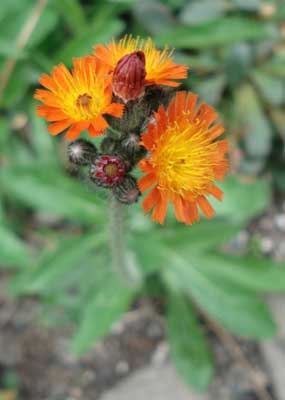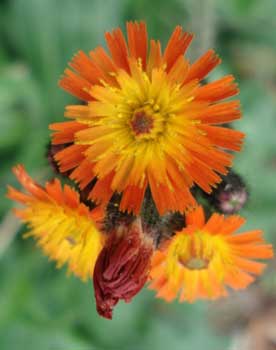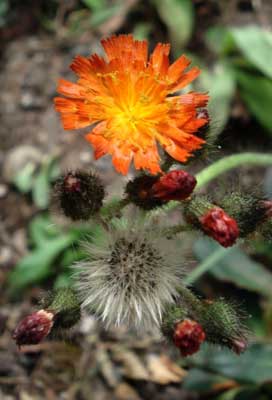
Orange Hawkeed
aka, King Devil,
Devil's Paintbrush,
Fox & Cubs,
Grim-the-Collier,
Wild Red Daisy
"Small herbs have grace,
Great weeds do grow apace."
-William Shakespeare
(1564-1616)
(1564-1616)
 One of the loveliest of wildflowers is the Orange Hawkweed (Hieracium aurantiacum; synonymous with Pilosella aurantiacum) which alas can be so aggressive & invasive that "weed" is even worked into its common name (and "Hawk's" weed because of an old Roman belief promulgated by Pliny, that hawks ate the blossoms to enhance their hunter vision).
One of the loveliest of wildflowers is the Orange Hawkweed (Hieracium aurantiacum; synonymous with Pilosella aurantiacum) which alas can be so aggressive & invasive that "weed" is even worked into its common name (and "Hawk's" weed because of an old Roman belief promulgated by Pliny, that hawks ate the blossoms to enhance their hunter vision).The orange hawkweed is a serious problem in many places throughout our state of Washington, on both sides of the Cascades, & in Idaho.
For some reason it's not very common right here on the Kitsap peninsula, though it seems only a matter of time. In our state it delights best in prairie settings with alternating wet & dry seasons, but is obviously adaptable.
As a generality it survives sustained cold & wetness better than sustained heat & dryness, though in our rainy weather alongside Puget Sound it establishes most strikingly on ledges or other fast-draining spots, acting like it dislikes wetter areas.
It has spread into the majority of the American states & throughout Canada, so like the dandylion, it's here to stay. It has further naturalized in all temperate regions of the world.
It originated in Europe, native from alpine regions of France & Italy, north & northeast to Poland, Finland & the Ukraine, together with all nearby nations. It grows nearer sea level & in places where temperatures are rather cold.
It's unfortunate it's so aggressive & in some places harmful, as it would otherwise be a delight. The furry leaves hug the ground & make a dense groundcover, semi-evergreen in mild zones. When it does die back, it grows back early from its fibrous roots & long rhizomes. So if it weren't itself a smothering weed that knocks out desirable perennials, it'd be the perfect flat-growing weed suppressor.
 Then of course there's the bright-bright orange-red blooms with deep yellow centers, beautiful as are so many aster-related weeds. They rise one or sometimes two feet above the flat leaves, on hairy stems.
Then of course there's the bright-bright orange-red blooms with deep yellow centers, beautiful as are so many aster-related weeds. They rise one or sometimes two feet above the flat leaves, on hairy stems.It was formerly a very popular garden flower due to its beauty, which is one big reason it spread worldwide. The seed fluff made it particularly successful at leaving gardens to invade the wilds of Tasmania, western Australia, New Zealand, & North America.
When it arrived in our garden I really wanted to keep it, & did let it spread for a bit, until I could get some good pictures. But ultimately I had to dig it out & compost it carefully, as Washington is one of the states that has put it on a banned list, along with Colorado, Idaho, Montana & Oregon. I think it's wasted effort to believe it can be kept at bay, but I have to obey the law & treat it as a foe.
Here in the northwest it is exceedingly well known as Orange Hawkweed, but a few people do know it as Devil's Paintbrush. It has other common names not heard locally, including Fairy's Paintbrush, Venus's Paintbrush, or Fireweed. The folkname "Fox & Cubs" alludes to the furry rosette of leaves which will send out runners giving rise to smaller furry rosettes of leaves.
One of its more unusual names is Grim-the-Collier, after a folk figure celebrated in plays & songs since the 1600s. Grim-the-Collier was a devil, sometimes associated with coal mines. The hairs of orange hawkweed's stems often have a sooty color, though what pops up locally does not have collier's soiling.
By literary & folk tale-spinning, Grim-the-Collier left Hell or Hades in the guise of a physician (one of the devil's favorite disguises) & discovered that mortal women were a lot more desirable than ever he imagined. He ended up abused & heartbroken for his interest, however, & returned to Hell thinking the mortal Earth is much more horrible than his own home.
In some folktales & literary treatments he's permitted a more successful romantic life, but whether doomed or successful at love, he's still a devil. As floriferous hawksweed is still a weed.
This association with the devil is carried over in such names as Devil's Paintbrush & King Devil (though King Devil is more often applied to the bright yellow Hieracium pretense).
It's devilishness probably arose from its capacity to invade freshly upturned soil & displace even native grasses, which for fields & meadows intended to grow fodder for cattle meant ruin to farmers.